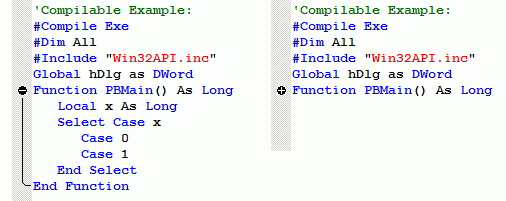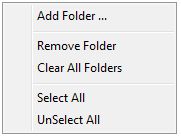 gbProcedureLibrary
gbProcedureLibrary
 gbProcedureLibrary scans source code files from one or more specified folders (and it's subfolders),
extracting user-specified structures and procedures into a Procedure Library. Folders to be excluded from the
search may be specified. Procedure content is indexed for easy browsing, searching and viewing. Libraries
(such as for a specific folder) may be saved and reopened. Duplicate procedures may be identified. Duplicates
may also be bookmarked for subsequent retrieval.
gbProcedureLibrary scans source code files from one or more specified folders (and it's subfolders),
extracting user-specified structures and procedures into a Procedure Library. Folders to be excluded from the
search may be specified. Procedure content is indexed for easy browsing, searching and viewing. Libraries
(such as for a specific folder) may be saved and reopened. Duplicate procedures may be identified. Duplicates
may also be bookmarked for subsequent retrieval.
As used in this Help document, the term Procedures is used to mean any of the following
PowerBASIC coding structures:
Sub, Function, Callback, Thread, Macro, FastProc, Class, Type, Enum, Union, Declare,
Interface, Method, and Property.
gbProcedureLibrary displays a list of all procedures in a ListView control, including a variety
of properties which include the procedure title, parent file, date, line count, and others. Selecting a
procedure from the list displays the procedure code in the embedded source code editor.
Alternately, the parent file of the procedure may be displayed in the source code editor.
A second code editor is available for split screen viewing of a long procedure or for
viewing two different procedures at the same time.
The embedded source editors offer advanced features. Syntax highlighting, call tips, autocompletion,
brace highlighting, code folding, code formatting and indentation guidelines are just some of the
features provided.
In addition to browsing, the user may search the Procedure Library. Searches can be limited to any
combination of properties (name, date, ...) up to and including the entire procedure code content.
Results of searches are displayed in a "Results" list, located above the list of all procedures.
The Results list is used to contain the results of a search, a list of all bookmarked
procedures, and a list of all unique (no duplicates) procedures in the library.
Procedures may also be sent to an editor/IDE of the user's choice, such as the PowerBASIC IDE,
for further editing or compilation.
Finally, gbProcedureLibrary can be used as the editor for an external source code file - such as
the parent file of a procedure or any other file on the user's PC. The file can be opened, edited,
and then saved to disk.
To install, just unzip the contents of the distribution file into a folder of its own!

Key Feature List
gbProcedureLibrary provides a variety of features.
- Builds Library of Procedures From Files
- Procedure Properties Include Procedure Name, Date, Parent File, Line Count, Procedure Type,
Parent Line Location, Library Line/Char Location, and MD5
- Display any Combination of Supported Procedure Properties
- Code Extraction From User-Specified File Types (*.bas, *.inc, ...)
- Code Extraction From HTML Files
- User-Specified List of Folders to Include in the Library (Subfolders Included)
- User-Specified List of Folders to Exclude from the Library (Subfolders Included)
- User-Specified List of Code Structures to Include in the Library (Sub, Function, Type, ...)
- Supports Sub, Function, Callback, Thread, Macro, FastProc, Class, Type, Enum, Union,
Declare, Interface, Method, and Property coding structures
- Search on Any Procedure Property, Including Full Content of the Procedure
- Secondary "Results" List for Display of Procedure Search Results
- Sort Procedure List on Any Property
- Visually Mark Duplicate Procedures
- Special Results Lists - Unique Procedures, ASM Procedures, and Bookmarked Procedures
- Advanced Source Code Editors (Two Editors Supported)
- View Selected Procedures in Source Code Editor
- View Same Procedure in Two Editors (Split Screen View))
- View Different Procedure in 2nd Editor (Dual Screen View)
- View Parent File in Source Code Editor
- Open Procedures in PowerBASIC Editor
- Open/Save Individual Source Code Files
- Local and Online Help
Advanced Editor Features
- Syntax Highlighting
- Source Code Formatting
- Open PowerBASIC Help at Highlighted Word
- Undo/Redo (Unlimited)
- Syntax Highlighting
- Brace Highlighting
- Indentation Guidelines
- AutoIndentation
- Call Tips (optionally Persistent)
- AutoCompletion
- Code Folding
- Line Numbers
- Active URLs
- Code Case (Upper/Lower/Mixed/As Typed)

Using gbProcedureLibrary
There are four basic activities you can do with gbProcedureLibrary. Build a library,
browse the library, search the library and edit source code.
Build
To build a procedure library, specify the properties which define the library content:
- File Types - *.bas, *.inc ...
- Start Folder(s)
- Exclude Folder
- Procedure Types to Include in the Library
-
Then just press the toolbar "Build" button. That will create the procedure library,
displayed as a list in the lower left part of the gbProcedureLibrary screen.
Browse
The procedure list can be scrolled. Clicking on column headers will sort the list in
ascending or descending order. List columns may be hidden from view if not required by
the user.
When an item on the list is selected, the full content of the procedure is shown in
the source code editor to the right.
Search
A secondary list of procedures may be generated in any of four ways,
and is displayed in the "Results" list (top left part of the gbProcedureLibrary screen).
- Search (Case Sensitive, Any Procedure Property and/or All Content)
- Bookmarked Procedures
- Unique Procedures
- ASM Procedures
To run a search, enter a search term in the dropdown combobox and press Enter (or the
toolbar Search button). Case sensitive searching is supported. Also, the search may be
limited to content of the displayed properties, or to the full content of the procedures'
source code.
The Bookmark, Unique, and ASM lists are essentially pre-defined search criteria which
the user can execute at any time.
Edit
The user may edit any code displayed in the source code editors. See a later section
on the advanced editing features provided by gbProcedureLibrary.
However the edits do not change the content of the Library. While the library is just a
text file and could be edited by the user, gbProcedureLibrary provides no capability
of directly editing the Procedure Library. The intent is for the Library content to always
match the corresponding content from the user's source code files.
Two source code editors are provided. The main editor (on the left) is used to display
procedures when a procedures is clicked in either the Main or Results lists. The secondary
editor (on the right) is used to display a copy of the main editor (split screen editing)
or a completely different procedure (dual view editing).
In addition to displaying procedures from the Procedure Library, external files may
be opened in the source code editors, modified, and then saved to disk. This same capability
can be used to save edited procedures to other files.

Start Folders And Exclude Folders
The user may select any number of folders, called "Start Folder", to scan while building a library.
The toolbar provides a button for selecting a Start Folder. If additional start folders are required
the Start Folders list may be used.
Pressing "Display" (leftmost button on the toolbar) will toggle through 3 displays:
- Main/Result Lists
- Additonal Start Folders / Exclude Folders
- Hiding all 4 Lists
When the Start/Exclude folder lists are shown, the context menu for each list can be used to
add or remove folders from each list.

Flexible GUI
The gbProcedureLibrary user interface may be modified by the user in several ways.
Minimal Toolbar
A minimal toolbar mode is available which removes several toolbar buttons, placing them
on dropdown menus. This significantly reduces the width of the gbProcedureLibrary interface.
Standard Toolbar:

Minimal Toolbar:

Toolbar Without Text
When first using gbProcedureLibrary users may find the text labels on the toolbar
buttons useful. But displaying the text significantly increases the width of the
toolbar. For users who no longer need the text labels, they may be removed:
With Text:

Without Text:

Optional Source Code Editor
By default gbProcedureLibrary displays a single source editor, whose content is
generated when the user clicks on a procedure in either the Main or Results list.
A second, optional source code editor may also be displayed. It is used for split
screen viewing of the Main procedure, to view a second procedure, or simply to view
an external source code file.
Rightmost Editor is Optional:

Start/Exclude Folders
The area where the Main/Results lists are shown can also be used to display the list of
Start Folders and Exclude folders. A dropdown menu item is available to toggle display
of the Main/Results and Start Folders/Exclude Folders pairs of lists.
Include/Exclude Folders Replace Main/Results List:
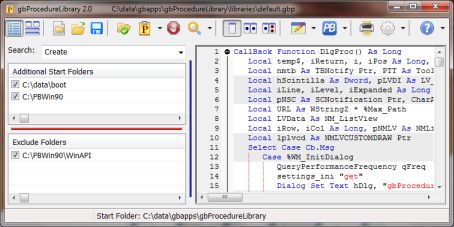
List Views
When the Main/Results lists are shown, the user can toggle whether one, or both, of the lists
are displayed. This provides the user as much screen area as possible to view the targeted
list.
Hidden Lists
All lists (Main, Result, Include and Exclude) may be hidden from view, allowing the entire
area of gbProcedureLibrary to be used for source code editing.
List are hidden:


Source Code Editors
The state-of-the-art editing features are available in both gbProcedureLibrary editors,
and are discussed in this section
Syntax Highlighting
Colors are used to distinguish keywords, strings, and comments from the rest
of the snippet content. User may select all highlighting colors.
The list of PowerBASIC keywords is kept in the file keywords.txt in the support_files
subfolder. That file may be edited as desired.
Unlimited Undo/Redo
The text editor supports undo/redo actions, limited only by the amount of memory
available on your PC. Undo/redo actions are taken by pressing the appropriate toolbar
button. If an action is not available, the toolbar button will be grayed out.
Code Formatting
gbProcedureLibrary can apply indentation to code, according to settings made by
the user. Settings are available for managing how blank lines, comments, indentation
and TABs are handled during formatting.
Before And After Formatting:
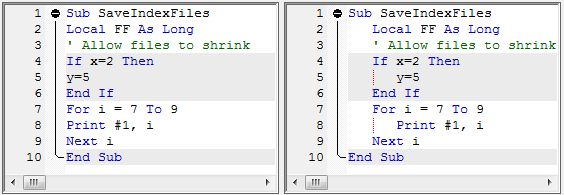
Brace Highlighting
This feature highlights the matching parenthesis, ( or ), when the cursor is placed
in front one of the character. An alternate highlighting is also applied if no matching
parenthesis is found.
Indentation Guidelines
The code editor can display vertical lines that correspond to a standard indentation,
which by default is 3 spaces. The vertical lines can help you align code, or it can
help you scan code to find starting and ending lines of code pairs, such as If/End If.
Greenbar Effect
In the early days of computing, source code was printed on wide paper whose
lines were alternately given white and green background colors. The alternating
background colors made it easier for the eye to track across lines of code.
The greenbar display provides a similar effect by alternating (every 3 lines)
between white and gray line backgrounds.
AutoIndentation
When the user presses enter, the cursor will be placed at the same level of indentation
as the line where enter was pressed. However, if the line begins with one of several
code constructs, indentation will be made one level lower than the current line.
Code constructs which result in extra indentation include:
If For
Else Do
Select Loop
Case While
Call Tips
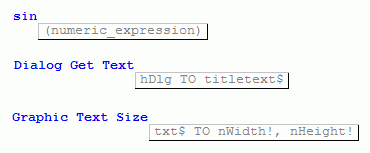 When a PowerBASIC function is typed in by the user, the text editor can display
a popup label containing a list of the arguments allowed by the function.
Some examples of call tips are shown in the image to the right.
When a PowerBASIC function is typed in by the user, the text editor can display
a popup label containing a list of the arguments allowed by the function.
Some examples of call tips are shown in the image to the right.
When the popup label is displayed, the user continues typing, filling in
the argument list per the displayed syntax. Pressing a space bar will
remove the display.
If the user enables Persistent Call Tips. the keyword sequence and the call tip
text are displayed permanently in the StatusBar, until the user takes another action
which reports status to the StatusBar.
The user may modify the list of recognized functions and the
corresponding argument syntax/list that is displayed. See the three files
words1.txt, words2.txt, and words3.txt in the support_files subfolder for
more information.
Persistent Call Tips
 Places a copy of the Call Tip into the StatusBar that persists even when the
Call Tip disappears from the screen.
Places a copy of the Call Tip into the StatusBar that persists even when the
Call Tip disappears from the screen.
AutoCompletion
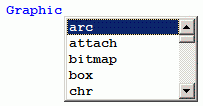 PowerBASIC keywords are often used in combination with one another, such as
"Control Add" or "Thread Get Priority". When the user types in a PowerBASIC
keyword that is part of a combination, a popup list of allowed keywords
needed to finish the combination, is displayed. The user can select from
that list (press TAB) or simply continue typing.
PowerBASIC keywords are often used in combination with one another, such as
"Control Add" or "Thread Get Priority". When the user types in a PowerBASIC
keyword that is part of a combination, a popup list of allowed keywords
needed to finish the combination, is displayed. The user can select from
that list (press TAB) or simply continue typing.
The user may modify the list of recognized keyword combinations.
See the two files members1.txt and members2.txt in the support_files subfolder
for more information.
Code Folding
When reviewing code it can be convenient to hide the code within procedures and
other code constructs. This is called folding and is demonstrated in the image below.
Code constructs may be folded by clicking on the minus symbol in the margin,
or unfolded by clicking on the plus symbol in the margin. The toolbar provides buttons
for folding/unfolding all constructs in a snippet.
The code constructs which gbProcedureLibrary recognizes are:
Type End Type Class End Class
Macro End Macro Interface End Interface
Sub End Sub Method End Method
Function End Function Property End Property
Callback End Function Union End Union
In general, folding can also be applied to lesser structures, such as Select/End Select,
but that level of folding is not currently supported by gbProcedureLibrary.
Open Help to Highlighted Word
Once a word is selected, the PowerBASIC Help file may be opened to the corresponding
Help file topic.
Line Numbers
The text editor supports the display of line numbers, contained in a left margin that
is separate from the text.
Active Links
gbProcedureLibrary supports hypertext links. Just as in a browser, the links are highlighted
and underlined, needing only to be clicked to open the link location. Simply type
in an HTTP address and click on the link to open the URL in your default browser.

Toolbar
All gbProcedureLibrary features and settings are accessed through the toolbar buttons.

Here's a description of the functions provided by the toolbar.

| Library
|
Displays the Procedure Library and Search controls
|

| View
|
Toggles display of the Main, Results, or Main+Results lists
|

| New
|
Creates a new, empty library
|

| Open
|
Open an existing library
|

| SaveAs
|
Saves the current library to a new file
|

| Folder
|
Selects the start folder for a build
|

| Build
|
Builds a new library
|

| Build
|
Cancels any active procedure library build
|

| Cancel Search
|
Search the Main list for procedures matching the search criteria
|

| Single View
|
Displays only the Left editor
|

| Split Screen
|
Displays both editors, with the same procedure in each editor. Changes to one
editor are reflected in the other.
|

| Dual View
|
Displays both editors, with a different procedure in each editor.
|

| Undo
|
Removes the latest change made in the text editor
|

| Redo
|
Reverses the last Undo action.
|

| Fold
|
Folds all procedures in the procedure's Compilable Example
|

| UnFold
|
UnFolds all procedures in the procedure's Compilable Example
|

| Indent
|
Indent the selected lines
|

| Outdent
|
Un-indent (outdent) the selected lines
|

| Comment
|
Comment the selected lines
|

| UnComment
|
UnComment the selected lines
|

| Open In IDE
|
Opens snippet's Compilable Example (uses default BAS editor)
|

| Print
|
Prints the content of the Left editor
|

| Settings
|
Displays summary information about the Procedure Library and gbProcedureLibrary settings
|

| Help
|
Opens this online Help page
|

Toolbar DropDown Menus
The dropdown menus associated with the toolbar buttons are described here:
Build Procedure Library
- Show Duplicates - Displays visual markers in the procedure listings, showing
which procedures are duplicates of one another. Note that the effectiveness of this
depends on how the user sorts the lists.
- Case Sensitive Searches
- Set File Types to Search - Sets the file extensions which will be searched for procedures
- Set Text Editor - Select the text editor to use when displaying the Procedure
Library (per the menu option above)
- Open Error Report - When extracting procedure names, any procedure whose end
line is not discovered is listed in a text file. This menu option opens that text
file in Notepad.
- Open Procedure Library - Opens the Procedure Library (a text file) in the
user-selected text editor. Notepad is the default text editor.
Build - Select Structures
- Sub - Sub
- Function - Function
- Declare - Declare Sub, Declare Function (external Subs/Functions)
- Callback - Callback Function
- Thread - Thread Function
- FastProc - FastProc
- Enum - Enum
- Type - Type
- Macro - Macro, Macro Function
- Union - Union
- Class - Class
- Interface - Interfaces, Interface IDBind, Declare Interface
- Property - Property Get, Property Set, Override Property Get, Override Property Set,
Declare Property Get, Declare Property Set, Declare Member Get, Declare Member Set, Declare Member Let
- Method - Thread Method, Method, Override Method, Class Method, Declare Method
- Select All - select all structures
- UnSelect All - unselect all structures
Search
Searches can be made on any combination of the Main list columns, as well as
including the full content of procedures. Just select the column names and/or "content"
to include the properties in a search.
Additionally, there are 3 Reports which allow the user to retrieve procedure lists in
way not possible when using the standard search.
- Procedure Name - name of the procedure
- Date - date of the parent file of the procedure
- File Name - name and extension of the parent file
- Type - type of procedure (sub, function, enum, ...)
- File Spec - full path of the parent file of the procedure
- Content - the full code of the procedure
- Select All - Select all items above for inclusion in searches
- UnSelect All - Remove all items above from searches
- Report: Unique Procedures - create a list of unique procedures
- Report: ASM Procedures - create a list of all procedures containing ASM code
- Report: Bookmarked Procedures - create a list of all bookmarked procedures
Edit
This button is shown only when the minimal toolbar is shown. It contains the
editing functions which are hidden with the minimal toolbar.
- Undo - restores the last editing change
- Redo - removes the last restored editing change
- Comment - places an apostrophe at the start of the selected lines
- UnComment - removes an apostrophe from the start of the selected lines
- Indent - moves code to the right (user-specified spaces per indent)
- Outdent - moves code to the left (user-specified spaces per outdent)
- Fold All - hides code within coding structures
- UnFold All - exposes code within coding structures
Open in IDE
- Select IDE - Select the external source code editor used when the "Open in
PowerBASIC IDE is selected
- Select PowerBASIC Help File - Select the Help file used when the "Open Selection
in PowerBASIC Help" menu is selected
Settings
- Use Syntax Highlighting - Toggles use of syntax highlighting
- Auto Copy - Copies procedures to the clipboard when the procedure is selected
Settings - Editor
These includes individual settings plus four second level menu groups:
- Line Numbers - Toggles display of line numbers in the editor margins
- Indentation Guides - Vertical lines displayed at each indentation level
- AutoIndent - When pressing Enter, has the editor indent to the appropriate level
- Brace Highlighting - Toggles color display of matching (and orphan) braces
- Alternating Line Colors - Alternates line background color every 3 lines
- Enable Hyperlinks - Located and activates URLs embedded in source code
- Call Tips - Displays a list of procedure arguments as the user types in a procedure name
- Call Tip Persistence - Displays persistent Call Tips in the statusbar
- AutoCompletion - Displays a list of possible keywords matching letters the user has typed
- Code Folding - Toggles hiding code between 1st/last lines of procedures
- Auto Formatting - Toggles hiding code between 1st/last lines of procedures
Settings - Colors
These set the colors for syntax highlighting:
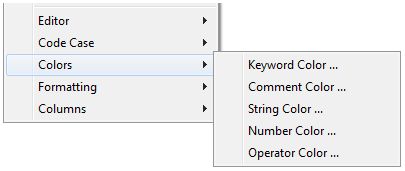
- Keyword Color - Set the color used to display keywords
- Comment Color - Set the color used to display comments
- String Color - Set the color used to display strings
- Number Color - Set the color used to display numbers
- Operators Color - Set the color used to display operators
Settings - Code Case
These set the code case that will be used with syntax highlighting:
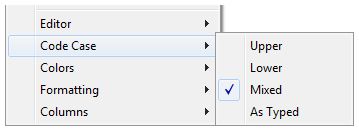
- Upper - Display keywords as upper text
- Lower - Display keywords as lower case
- Mixed - Display keywords as mixed text
- As Typed - No case change. Displays as typed by the user.
Settings - Formatting
These are used to control various aspects of formatting source code:
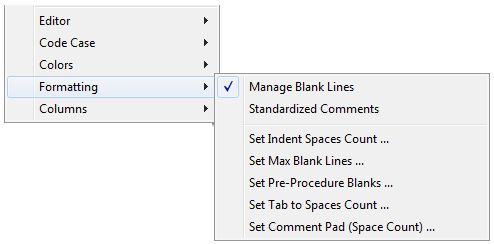
- Manage Blank Lines - Controls the location and count of blank lines
- Standardized Comments - Inserts space(s) after apostrophe
- Set Indent Spaces Count - Determine the number of spaces per indentation level
- Set Max Blank Lines - Maximum number of consecutive blank lines
- Set Pre-Procedure Blanks - Number of blank lines before a procedure
- Set Tab to Spaces Count - Number of spaces used to replace a TAB character
- Set Comment Pad - Number of spaces used in standardized comments
Settings - Columns
Check the columns you wish see in the Main and Results lists. The columns are not
removed, just set to zero width.

- Name thru Parent LineSelected columns will be visible
- Select All - Check all columns
- UnSelect All - Uncheck all columns
Help
- Local Help - Open a local copy of gbProcedureLibrary help.

Context Menus
The context menus associated with the various gbProcedureLibrary controls are described here:
Main ListView (Entire Procedure Library)
- Use as Right Views - Copy procedure to the rightmost editor (Dual View mode)
- Bookmark Procedure - Bookmark the selected procedure
- Clear Bookmark - Remove the bookmark from the selected procedure
- Clear All Bookmarks - Remove all bookmark from all procedures
- Show Bookmarked Procedures - Display a list of all bookmarked procedures
- Show Unique Procedures - Display a list of procedures with all duplicates removed
- Open Containing File in Left View - Opens the procedure's parent file
- Open Containing File in IDE - Opens the procedure's parent file in the PowerBASIC IDE
- Open Containing Folder - Opens procedure's parent file folder
Results ListView (Search, Unique, Bookmarks or ASM Procedures)
- Use as Right Views - Copy procedure to the rightmost editor (Dual View mode)
- Bookmark Procedure - Bookmark the selected procedure
- Clear Bookmark - Remove the bookmark from the selected procedure
- Clear All Bookmarks - Remove all bookmark from all procedures
- Show Bookmarked Procedures - Display a list of all bookmarked procedures
- Show Unique Procedures - Display a list of procedures with all duplicates removed
- Remove From List - Remove selected procedure from list
- Clear List - Remove all procedures from the Results list
- Open Containing File in Left View - Opens the procedure's parent file
- Open Containing File in IDE - Opens the procedure's parent file in the PowerBASIC IDE
- Open Containing Folder - Opens procedure's parent file folder
Start Folders / Exclude Folder Lists (ListView)
Both folder lists use the same, following, context menu:
- Add Folder - Select/Add an additional folder
- Remove Folder - Remove the folder from the list
- Clear All Folders - Clear the folder list
- Select All - Check all folders in the list
- UnSelect All - UnCheck all folders in the list
Source Code Editors

- Cut - Delete selected text (all text if no selection) and place on clipboard
- Copy - Copy selected text (all text if no selection)
- Paste - Paste text into the editor at the caret
- Delete - Delete the selected text
- Clear All - Remove all text in the editor
- Copy All - Copy all text in the procedure
- Undo - Undo latest editing action
- Redo - Restore last undo action
- Comment - Add comment character to selected lines
- UnComment - Remove comment character from selected lines
- Indent - Move code 3 spaces to the right
- Outdent - Move code 3 spaces to the left
- Fold All - Hide all procedure code (leaves 1st/last lines of procedure visible)
- UnFold All - Display all procedure code
- Remove Blank Lines - Removes blank lines, including lines containing only spaces
- Left Justify - Removes all spaces on the left side of all lines
- Format Code - Formats source code, including controlling blank line counts
- Open External File - Select a file whose content will be displayed in the left editor
- Save As External File - Save content of the left editor to a user-specified file
- Open Selection in PowerBASIC Help - Open the user-specified Help file to the
topic corresponding to the selected text
- Open Procedure in PowerBASIC IDE - Save selected text to a temp file. Open that file
in a user-specified IDE

Keyboard Shortcuts
The following key combinations are available to the user to access gbProcedureLibrary features:
- F1 - Help
- Ctrl+B - Build Procedure Library
- Ctrl+L - Toggle Display of Library

Other Comments
Comments and suggestions are welcome!
 gbProcedureLibrary scans source code files from one or more specified folders (and it's subfolders),
extracting user-specified structures and procedures into a Procedure Library. Folders to be excluded from the
search may be specified. Procedure content is indexed for easy browsing, searching and viewing. Libraries
(such as for a specific folder) may be saved and reopened. Duplicate procedures may be identified. Duplicates
may also be bookmarked for subsequent retrieval.
gbProcedureLibrary scans source code files from one or more specified folders (and it's subfolders),
extracting user-specified structures and procedures into a Procedure Library. Folders to be excluded from the
search may be specified. Procedure content is indexed for easy browsing, searching and viewing. Libraries
(such as for a specific folder) may be saved and reopened. Duplicate procedures may be identified. Duplicates
may also be bookmarked for subsequent retrieval.
 gbProcedureLibrary
gbProcedureLibrary











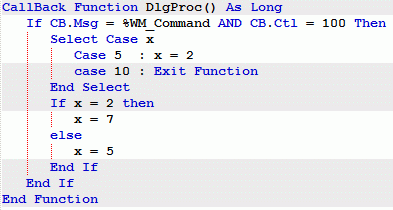
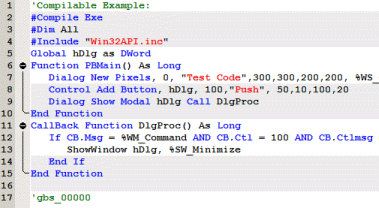
 When a PowerBASIC function is typed in by the user, the text editor can display
a popup label containing a list of the arguments allowed by the function.
Some examples of call tips are shown in the image to the right.
When a PowerBASIC function is typed in by the user, the text editor can display
a popup label containing a list of the arguments allowed by the function.
Some examples of call tips are shown in the image to the right.
 Places a copy of the Call Tip into the StatusBar that persists even when the
Call Tip disappears from the screen.
Places a copy of the Call Tip into the StatusBar that persists even when the
Call Tip disappears from the screen.
 PowerBASIC keywords are often used in combination with one another, such as
"Control Add" or "Thread Get Priority". When the user types in a PowerBASIC
keyword that is part of a combination, a popup list of allowed keywords
needed to finish the combination, is displayed. The user can select from
that list (press TAB) or simply continue typing.
PowerBASIC keywords are often used in combination with one another, such as
"Control Add" or "Thread Get Priority". When the user types in a PowerBASIC
keyword that is part of a combination, a popup list of allowed keywords
needed to finish the combination, is displayed. The user can select from
that list (press TAB) or simply continue typing.
